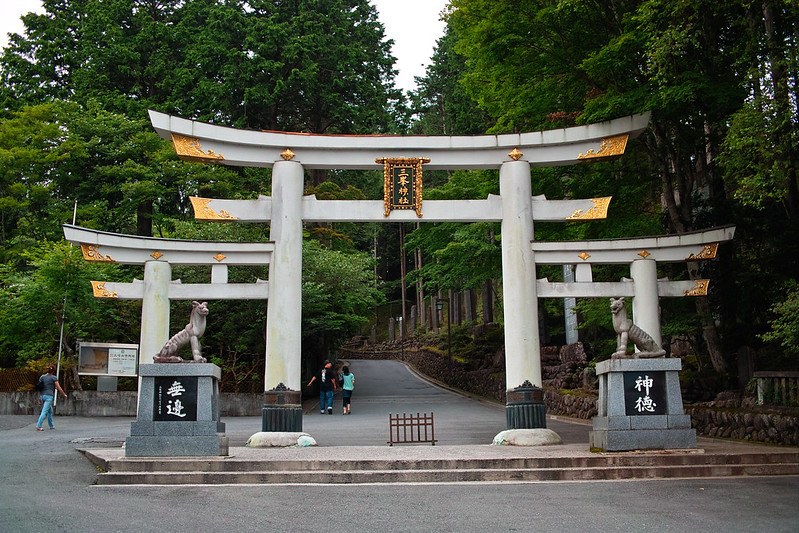鳥居
Torii
Torii (鳥居), are gateways that are placed at the entrance(s) of Shinto shrines. They make the symbolic transition between the normal human world and the spiritual.
Paths up to Shinto shrines may be lined with several Torii. Each additional gateway represents increased holiness the closer and closer one draws to the shrine. The first gateway at the entrance(s) is called the ichi no torii (一の鳥居), meaning the "first torii". The next is called the ni no torii (二の鳥居), meaning the "second torii". The pattern continues for each additional Torii gate.
Aside from Shinto shrines, Torii also stand in front of the tombs of Emperors and on other sacred spots.
— Origin
It is unknown where Torii came from originally. Some believe that they were derived from Torana, a similar looking gateway at the entrance of Buddhist shrines, stupa, or Hindu temples in India. This theory states that the Torana was brought along with Buddhism when it first came to Japan.
Other's believe that the Torii came from the Chinese Paifang, which itself was derived from the Torana when Buddhism was introduced in China.
Furthermore, some believe that they would have come from the Korean Hongsalmun, which have the same origin story as the Paifang.
There is, of course, some discussion as to Torii being a purely Japanese invention.
— Structure
Traditionally, Torii were made of stone or wood, but today they can also be constructed in reinforced concrete, copper, or other such materials. They may be painted or unpainted. Generally, painted ones are painted in black and vermilion or orange. Rarely do you see them painted in other colors.
When painted in black and vermilion, only the kasagi and nemaki are painted in black.
The main two upright support pillars are called hashira (柱). At the very top is a horizontal beam called the kasagi (笠木). The hashira are held together with a tie-beam called nuki (貫).
The nuki is accompanied by ornamental wedges called kusabi (楔). It may also be accompanied by a supporting strut called the gakuzuka (額束). The gakuzuka may have a tablet on it that has the name of the shrine written on it.
The lintel at the top of the gateway is the kasagi, and it may be paired with with a second lintel called the shimaki (島木). Depending on which of the two families of styles it belongs to, they may have an upward curve called sorimashi (反り増し), or may be straight.
The hashira are often supported by white, round stones at their base called kamebara (亀腹) or daiishi (台石). Occasionally, they are replaced with a black decorative sleeve we called the nemaki (根巻).
Where the hashira meet the kasagi, sometimes there may be a decorative ring that is called the daiwa (台輪).
— Styles
Shinme Torii Family:

Shime Torii

Shinmei Torii

Geku/Ise Torii

Kashima Torii

Kasuga Torii

Hachiman Torii

Mihashira Torii
・Shime Torii (注連鳥居)
This type of Torii is the most simple, as it is just two posts with a shimenawa (標縄) rope held between them.
・Shinmei Torii (神明鳥居)
This Torii gives name to its family, and is thought to be the oldest style. It is made up only of hashira, kasagi, and nuki.
・Ise Torii (伊勢鳥居)
This Torii is found only around the Ise Shrine in Mie Prefecture. There are two subtypes: Both are very similar to shinmei torii. The first has hashira that have a slight inward slant and its nuki are held in place with pentagonal shaped kusabi with ends that are slightly thicker. The second is similar to the first, but has a secondary shimaki under the pentagonal kusabi set.
・Kashima Torii (鹿島鳥居)
This Torii noted for its nuki protruding from its sides and its kusabi. It does not have inward slanting hashira. Named after the torii found at Kashima Shrine.
・Kasuga Torii (春日鳥居)
A torii with straight aligned kasagi.
・Hachiman Torii (八幡鳥居)
Hachiman Torii are identical to kasuga torii in all but that the kasagi are at a slight downward slant. They are often used at Hachiman shrines.
・Shiromaruta Torii (白丸太鳥居)
This Torii is a shinmei torii who's logs have been stripped of of its bark. These types are placed at the tombs of Emperors.
・Mihashira Torii (三柱鳥居)
Mihashira Torii is a special type that is made from three torii. It is believed to have been created by early Japanese Christians to represent the Holy Trinity.
Myoujin Torii Family:

Myoujin Torii

Nakayama Torii

Inari/Daiwa Torii

Ryoubu Torii

Miwa Torii

Usa Torii

Nune Torii

Sannou Torii

Hizen Torii
・Myoujin Torii (明神鳥居)
This is by far the most common Torii. Its kasagi and shimaki are curved upwards and have kusabi. They are usually painted vermillion and black or left unpainted. They can be made from wood, stone, reinforced concrete, or other materials.
・Nakayama Torii (中山鳥居)
This type is identical to myoujin torii in all but that the nuki does not protrude and the kasagi/shimaki are curved upwards more that usually. Named after the one found in Nakayama Shrine.
・Daiwa/Inari Torii (大輪鳥居・稲荷鳥居)
These types have daiwa at the top of the pillars. The name "inari" came from that these were often used at Inari Shrines. This style came about during the Heian period.
・Ryōbu Torii (両部鳥居)
The "four legged torii." It is a daiwa torii that is reinforced with square pillars on both sides of the hisashi.
・Miwa Torii (三輪鳥居)
This type of torii is created from three myoujin torii, but with no hisashi inclination. They can be with or without a set of doors.
・Usa Torii
This type of torii is a myoujin torii, with no gakuzuka.
・Nune Torii
This is a daiwa torii with a small gable above the gakuzuka.
・Sannō Torii (山王鳥居)
This type of torii has a gable over the kasagi and shimaki.
・Hizen Torii (肥前鳥居)
Hizen torii are unusual torii with rounded kusagi and hisashi that flare downwards.








